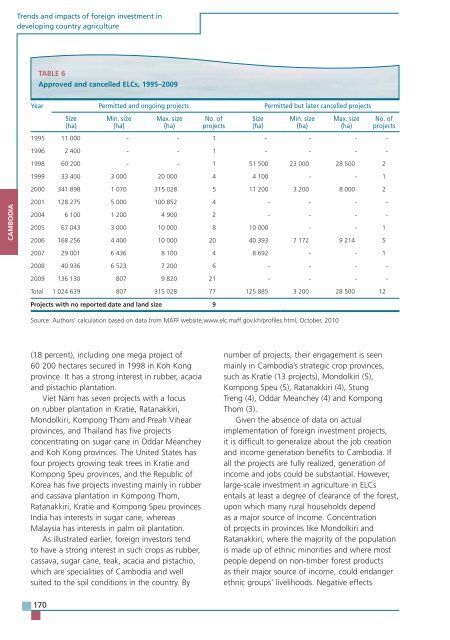TRENDS AND IMPACTS OF FOREIGN INVESTMENT IN DEVELOPING COUNTRY AGRICULTURE
TRENDS AND IMPACTS OF FOREIGN INVESTMENT IN DEVELOPING COUNTRY AGRICULTURE
TRENDS AND IMPACTS OF FOREIGN INVESTMENT IN DEVELOPING COUNTRY AGRICULTURE
Create successful ePaper yourself
Turn your PDF publications into a flip-book with our unique Google optimized e-Paper software.
CAMBODIA<br />
Trends and impacts of foreign investment in<br />
developing country agriculture<br />
TABLE 6<br />
Approved and cancelled ELCs, 1995–2009<br />
Year Permitted and ongoing projects Permitted but later cancelled projects<br />
Source: Authors’ calculation based on data from MAFF website,www.elc.maff.gov.kh/profiles.html, October, 2010<br />
(18 percent), including one mega project of<br />
60 200 hectares secured in 1998 in Koh Kong<br />
province. It has a strong interest in rubber, acacia<br />
and pistachio plantation.<br />
Viet Nam has seven projects with a focus<br />
on rubber plantation in Kratie, Ratanakkiri,<br />
Mondolkiri, Kompong Thom and Preah Vihear<br />
provinces, and Thailand has five projects<br />
concentrating on sugar cane in Oddar Meanchey<br />
and Koh Kong provinces. The United States has<br />
four projects growing teak trees in Kratie and<br />
Kompong Speu provinces, and the Republic of<br />
Korea has five projects investing mainly in rubber<br />
and cassava plantation in Kompong Thom,<br />
Ratanakkiri, Kratie and Kompong Speu provinces.<br />
India has interests in sugar cane, whereas<br />
Malaysia has interests in palm oil plantation.<br />
As illustrated earlier, foreign investors tend<br />
to have a strong interest in such crops as rubber,<br />
cassava, sugar cane, teak, acacia and pistachio,<br />
which are specialities of Cambodia and well<br />
suited to the soil conditions in the country. By<br />
170<br />
Size<br />
(ha)<br />
Min. size<br />
(ha)<br />
Max. size<br />
(ha)<br />
No. of<br />
projects<br />
Size<br />
(ha)<br />
Min. size<br />
(ha)<br />
Max. size<br />
(ha)<br />
No. of<br />
projects<br />
1995 11 000 - - 1 - - - -<br />
1996 2 400 - - 1 - - - -<br />
1998 60 200 - - 1 51 500 23 000 28 500 2<br />
1999 33 400 3 000 20 000 4 4 100 - - 1<br />
2000 341 898 1 070 315 028 5 11 200 3 200 8 000 2<br />
2001 128 275 5 000 100 852 4 - - - -<br />
2004 6 100 1 200 4 900 2 - - - -<br />
2005 67 043 3 000 10 000 8 10 000 - - 1<br />
2006 168 256 4 400 10 000 20 40 393 7 172 9 214 5<br />
2007 29 001 6 436 8 100 4 8 692 - - 1<br />
2008 40 936 6 523 7 200 6 - - - -<br />
2009 136 130 807 9 820 21 - - - -<br />
Total 1 024 639 807 315 028 77 125 885 3 200 28 500 12<br />
Projects with no reported date and land size 9<br />
number of projects, their engagement is seen<br />
mainly in Cambodia’s strategic crop provinces,<br />
such as Kratie (13 projects), Mondolkiri (5),<br />
Kompong Speu (5), Ratanakkiri (4), Stung<br />
Treng (4), Oddar Meanchey (4) and Kompong<br />
Thom (3).<br />
Given the absence of data on actual<br />
implementation of foreign investment projects,<br />
it is difficult to generalize about the job creation<br />
and income generation benefits to Cambodia. If<br />
all the projects are fully realized, generation of<br />
income and jobs could be substantial. However,<br />
large-scale investment in agriculture in ELCs<br />
entails at least a degree of clearance of the forest,<br />
upon which many rural households depend<br />
as a major source of income. Concentration<br />
of projects in provinces like Mondolkiri and<br />
Ratanakkiri, where the majority of the population<br />
is made up of ethnic minorities and where most<br />
people depend on non-timber forest products<br />
as their major source of income, could endanger<br />
ethnic groups’ livelihoods. Negative effects


